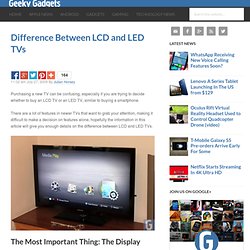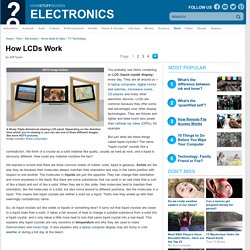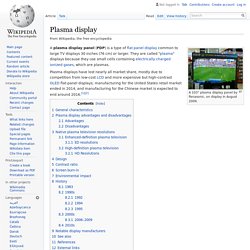

Difference Between LCD and LED TVs. Purchasing a new TV can be confusing, especially if you are trying to decide whether to buy an LCD TV or an LED TV, similar to buying a smartphone.

There are a lot of features in newer TVs that want to grab your attention, making it difficult to make a decision on features alone, hopefully the information in this article will give you enough details on the difference between LCD and LED TVs. The Most Important Thing: The Display The one main important thing to remember though is the display. After all, it will be the centerpiece of your multimedia setup. From playing games to watching movies and shows, your TV is where your eyes will be most of the time once you turn it on. Checking out televisions for sale at your local shopping mall may be helpful to some degree, since you can see for yourself how accurately the display renders colors and the difference between displays once they’re stacked against each other. LED or LCD: It’s The Back Lighting The Best Choice For Picture Quality.
LED vs. LCD TV: Which is better? [update] - Feature - TVs. Updated November 2013!
![LED vs. LCD TV: Which is better? [update] - Feature - TVs](http://cdn.pearltrees.com/s/pic/th/led-lcd-vs-plasma-117146739)
In television technology trifecta of LED LCD, plasma, and LCD, which comes out on top? The subject of countless debates and diatribes, the better question is: which works best? Or more precisely, which works best for you? When you cut through the hype and the fanboys, each tech has different benefits and costs. How LCDs Work" You probably use items containing an LCD (liquid crystal display) every day.

They are all around us -- in laptop computers, digital clocks and watches, microwave ovens, CD players and many other electronic devices. LCDs are common because they offer some real advantages over other display technologies. They are thinner and lighter and draw much less power than cathode ray tubes (CRTs), for example. But just what are these things called liquid crystals? The name "liquid crystal" sounds like a contradiction. Plasma display. A 103" plasma display panel by Panasonic, on display in August 2009.

Plasma displays have lost nearly all market share, mostly due to competition from low-cost LCD and more expensive but high-contrast OLED flat-panel displays; manufacturing for the United States retail market ended in 2014, and manufacturing for the Chinese market is expected to end around 2016.[1][2] General characteristics[edit] Plasma displays are bright (1,000 lux or higher for the module), have a wide color gamut, and can be produced in fairly large sizes—up to 3.8 metres (150 in) diagonally.
They had a very low-luminance "dark-room" black level compared with the lighter grey of the unilluminated parts of an LCD screen at least in the early history of the competing technologies (in the early history of plasma panels the blacks were blacker on plasmas and greyer on LCDs).[3] LED-backlit LCD televisions have been developed to reduce this distinction. Plasma display advantages and disadvantages[edit] OLED. Prototype OLED lighting panel developed by Lumiotec Demonstration of a flexible OLED device There are two main families of OLED: those based on small molecules and those employing polymers.

Adding mobile ions to an OLED creates a light-emitting electrochemical cell or LEC, which has a slightly different mode of operation. OLED displays can use either passive-matrix (PMOLED) or active-matrix addressing schemes. OLED Components" LCD Monitor Buyer’s Guide: Spring 2010. Page 3. Pages: [ 1 | 2 | 3 | 4 | 5 | 6 | 7 | 8 ] LED Backlight Monitors with LED backlight, often referred to as LED monitors (which is not quite correct because true LED monitors are those huge ad billboards in which the image is indeed formed by LEDs), have been quickly gaining popularity.

They were expensive, premium-class products at first, but now, for example, BenQ offers a 19-incher with LED backlight for less than $200. But if we are going to talk about the real, not marketing, advantages, we want to know what type of LED backlight we mean. There are three of them available today: Backlight. A backlight is a form of illumination used in liquid crystal displays (LCDs).

As LCDs do not produce light themselves (unlike for example Cathode ray tube (CRT) displays), they need illumination (ambient light or a special light source) to produce a visible image. Backlights illuminate the LCD from the side or back of the display panel, unlike frontlights, which are placed in front of the LCD. Backlights are used in small displays to increase readability in low light conditions such as in wristwatches,[1] and are used in computer displays and LCD televisions to produce light in a manner similar to a CRT display. A review of some early backlighting schemes for LCDs is given in a report by Peter J. Wild IEEE First-Hand History[2] under its section Backlit LCDs.
Simple types of LCD displays such as in digital watches are built without an internal light source, requiring external light sources to convey the display image to the user. Light source types[edit] Backlights come in many colors. Monitor LED Backlighting. Monitors buying guide. If you own a desktop computer, you'll need a monitor.

The best overall monitor right now is the Dell UltraSharp U2713HM . It delivers fantastic performance on an extreme-definition (2,560x1,440-pixel), 27-inch screen, with great ergonomic options, and a useful assortment of connections, for $800. If that number sounds too rich for your blood, the Asus PA248Q sells for as low as $310, with a 24-inch, 1,920x1,200-pixel screen, ergonomic options, each major video connection, and unique and useful customization settings.
Finally, if money is no object and owning the absolute best performer is a priority, the HP DreamColor LP2480zx should be your one and only choice.